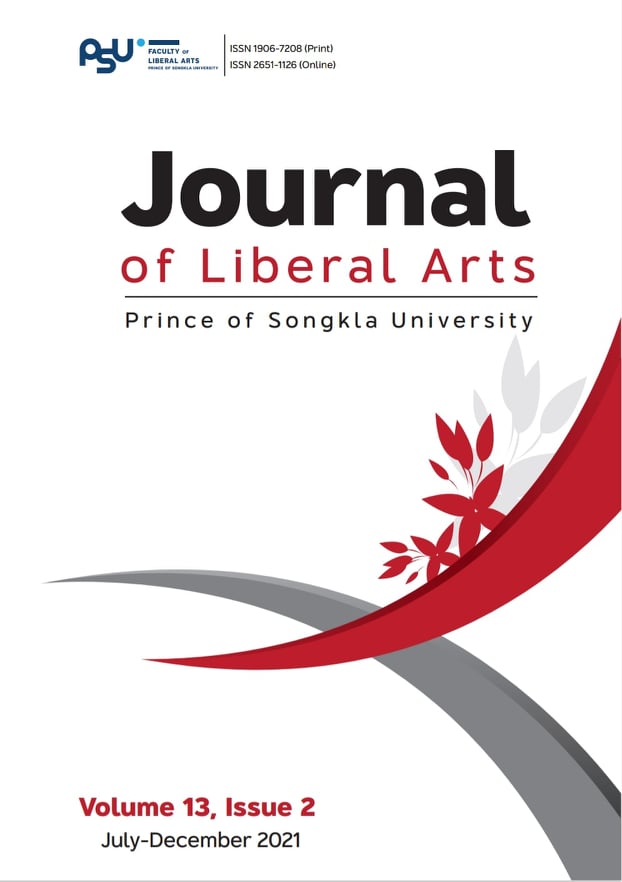Pronunciation of Standard Thai Vowels by Non-native Speakers
DOI:
https://doi.org/10.14456/jlapsu.2021.3Keywords:
acoustic study, second language learning, standard Thai vowelsAbstract
This study aimed to analyze the acoustic characteristics of Standard Thai vowels produced by Khmer, Vietnamese, Burmese, and Malay speakers. The test words comprised eighteen monophthongs /i e ɛ ɨ ə a u o ɔ ii ee ɛɛ ɨɨ əə aa uu oo ɔɔ/. The informants were composed of three speakers with high experience in Thai from each language and three speakers with low experience in Thai from each language, comprising a total of twenty-four speakers. The informants’ speech was recorded directly by a computer. The total number of test tokens for acoustical analysis was 2,592. Formant frequencies (F1 and F2) and duration of vowels were measured using the Praat program. The results showed that the acoustic characteristics of Thai vowels produced by Khmer, Vietnamese, Burmese, and Malay native speakers with high experience in Thai were better than those with low experience in Thai. Greater variation of vowels caused by tongue height position was found for speakers with low experience in Thai because high vowels, mid vowels, and low vowels are highly overlapped. For vowel length, almost all of the speakers with both high and low experience in Thai produced short and long vowels with duration ratios similar to native Thai speakers. However, vowel duration varied for speakers with low experience in the Thai language.
References
Abramson, A. S. (1962). The vowels and tones of Standard Thai: Acoustical measurements and experiments. University Microfilms International.
Cebrian, J. (2006). Experience and the use of non-native duration in L2 vowel categorization. Journal of Phonetics, 34(3), 372-387.
Crowley, T. (1997). An introduction to historical linguistics (3rd ed.). Oxford University Press.
Đào, Đ. M., & Nguyễn, A-T. T. (2019). Adult L2 Japanese learners’ production and perception of Vietnamese monophthong vowels. Journal of Second Language Teaching & Research, 7(1), 81-106.
Evans, B. G., & Alshangiti, W. (2018). The perception and production of British English vowels and consonants by Arabic learners of English. Journal of Phonetics, 68, 15-31.
Flege, J. E., & Wayland, R. (2019). The role of input in native Spanish late learners’ production and perception of English phonetic segments. Journal of Second Language Studies, 2(1), 1-44.
Flege, J. E., Bohn, O., & Jang, S. (1997). Effects of experience on non-native speakers’ production and perception of English vowels. Journal of Phonetics, 25, 437-470.
Gandour, J. (1984). Vowel duration in Thai. Crossroads: An Interdisciplinary Journal of Southeast Asian Studies, 2(1), 59-64.
Intajamornrak, C. (2003). The acoustic characteristics of vowels produced by Thai tracheoesophageal and normal speakers and the perception of tracheoesophageal vowels. In L-Thongkum (Ed.), The accent of Thai alaryngeal Thai speakers. (pp. 73-95). Chulalongkorn University Press. [in Thai]
Luangthongkum, T., & Graduate Students. (2011). Thai sounds: An acoustic studies. Chulalongkorn University Press. [in Thai]
Modehira, P. (2005). Correction making among Thais and Americans: A study of cross-cultural and interlanguage pragmatics [Doctoral dissertation, Chulalongkorn University]. Thai thesis database.HTTP://
www.thaithesis.org/detail.php?id=1082548000563 [in Thai]
Phalipat, S. (2009). A comparison of the acoustic characteristics of Hmong, Mien and Mal vowels. In M. Makoto, K. Thepkanjana, W. Aroonmanakun, & M. Endo (Eds.), Proceedings of the Chulalongkorn-Japan Linguistics Symposium. (pp. 183-194). CbLLE Tokyo University of Foreign Studies.
Phiasuphan, K. (2014). A comparison study of Bangkok Thai tones spoken by Thai and Indian speakers: A case study of gender. Journal of Language and Culture, 33(2), 65-89.
Romig, S. (2017). The production and perception of English vowels by native speakers of Brazilian Portuguese living in Victoria, Canada [Master’s thesis, University of Victoria]. https://dspace.library.uvic.ca/handle/1828/8471?show=full
Roengpitya, R. (2001). A study of vowels, diphthongs, and tones in Thai [Doctoral dissertation, University of California, Berkeley]. https://escholarship.org/uc/item/1qq9g93z
Sinthawashewa, T. (2009). The Bangkok Thai tones produced by Japanese speakers: An acoustic and perception study [Master’s thesis, Chulalongkorn University]. http://cuir.car.chula.ac.th/handle/123456789/20001
Suebsor, K. (2019). Thai Tones of Cambodian Speaker Aged 6-12 [Master’s thesis, Thammasat University]. file:///C:/ Users/STD/Downloads/DigitalFile%231_578469.pdf
Teeranon, P. (2016). An acoustic analysis and perceptual study of Thai tones produced by Vietnamese and Khmer speakers. Journal of Language and Culture, 35(1), 81-100. [in Thai]
Thein-Tun, U. (1982). Some acoustic properties of tones in Burmese. In D. Bradley (Ed.), Tonation, Pacific Linguistics Series A 62, Australian National University.
Wong-ampai, N. (2009). The Bangkok Thai tones produced by Pattani Malay children of 6-7 years old: An acoustic and perception study [Master’s thesis, Chulalongkorn University]. https://www.car.chula.ac.th/display7.php?bib=b1863922
Yen-Chen, H. (2017). Second language perception of Mandarin vowels and tones. Language and Speech, 61(1), 135-152.
Yoon, J-H. (2018). The effect of language experience on the production and perception of English vowels by native Korean speakers [Master’s thesis, Ewha Womans University]. https://dspace.ewha.ac.kr/Handle/2015.oak/245783
Downloads
Published
How to Cite
Issue
Section
License
Copyright (c) 2021 Chommanad Intajamornrak

This work is licensed under a Creative Commons Attribution-NonCommercial-NoDerivatives 4.0 International License.
The authors retain the copyright to their article but the Journal of Liberal Arts, Prince of Songkla University reserves the exclusive rights to first publication.






